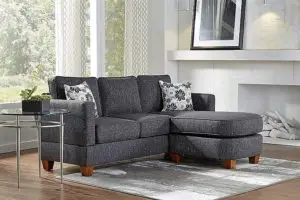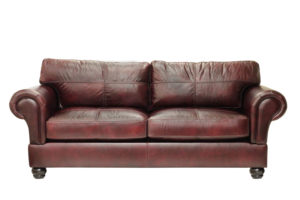Sofa lifespans fall into different categories. The best sofas will last 20 years or more, but you can expect to pay $3000 or more.
Most articles written about sofa quality and lifespan recommend features that are only available in expensive sofas that few people can afford. These features include solid hardwood frames that are screwed, glued, corner blocked and double doweled. 8 way hand tied spring foundations are another feature found only in expensive seating.

Although these articles are not wrong, they do not to apply to 90% of upholstered seating available in stores.
This article is targeted at how to find moderately priced furniture that will last as long as possible, even if it is not the 20+ years obtainable for those with unlimited budgets.
A recent furniture industry survey indicated that most consumers currently expect their new sofas to last only 3–5 years.
That is a pretty accurate assessment for most mid-priced mass produced couches and sofas.
Many of these mass produced sofas are made with cheap plywood or engineered wood frames and low cost sinuous wire (no-sag) foundations.
Inexpensive frame and foundation components, however, are not the biggest limitation on your sofa’s expected lifespan.
 Even inexpensive frames and foundations usually hold up for 10 years or more.
Even inexpensive frames and foundations usually hold up for 10 years or more.
Seat cushions usually fail long before frames and foundations.
The expected lifespan of a foam cushion is primarily dependent on the density and thickness of the foam.
1.8 density foam is by far the most commonly used for low and mid-priced residential furniture seat cushions.
These 1.8 density cushions will typically begin to lose their shape and comfort within 1 – 3 years and will need replacement within 3-5 years.
There are many couches sold with cheaper (and lighter weight) 1.5 density foam that will deteriorate even more rapidly, sometimes within one year of purchase.
Not all manufacturers or retailers will list foam densities. Foam that is described as “high density” without any specific number usually has a density of 1.8.
Higher densities (2.0 – 2.5) can be found on more expensive residential furniture that can be expected to last longer than 5 years.
Furniture designed for heavy commercial or institutional use may use foam with densities of 3.0 or higher.
Another important factor is whether the foam is HR (High Resiliency) which recovers its shape better after being compressed.
Uneducated consumers frequently confuse “firmness” and “density.” They mistakenly think that “firmer” cushions are more durable.
The higher the foam density (and the heavier the weight of the cushion) the more it will cost. Variations in firmness do not affect cost, weight or density.
Cushions made with coil springs are usually (but not always) more durable than the standard 1.8 density foam cushions.
These coil springs are surrounded by a foam border and then padded on the top and bottom with additional soft padding.
Down/feathers are often used as the padding in combination with coil springs. A down/feather “jacket” is used as a layer of padding on the top and bottom to soften the feel of the cushion.
When shopping for a couch always test the cushions by picking them up. As a general rule if the seat cushions feel “light” you are looking at a couch with a very short expected lifespan.
As a general rule, the heavier a seat cushion is the longer your sofa will last.
Lifespans of 5+ years are also helped by using durable “heavy-duty” fabrics with high stain resistance.
Synthetic fibers such as polyesters and olefins generally provide the best combination of durability, stain resistance and price for mid-priced furniture.
Natural fibers such as cotton, linen and wool are generally (but not always) less durable and less stain resistant.
Heavy weight fabrics can be more durable, but there are also many lighter weight synthetic fabrics that will give you 5–10 years of use.
Long lasting sofas can be found from many sources. If you are willing to pay $3000 or more for a sofa (in a reasonably priced fabric) you have many choices.
It will be very difficult finding a sofa for less than $1000 that will last longer than 5 years (and still look good.)
Between those two price points concentrate on the best possible seat cushions you can get and choose a durable stain-resistant fabric.
There are many other styling, construction and tailoring features that will also affect cost, but seat cushions and fabric are the two most important individual factors for maximizing the expected lifespan of your sofa.
Know someone who might be interested in this post? Please like and share this post with them. If you have questions or comments please leave them below.
